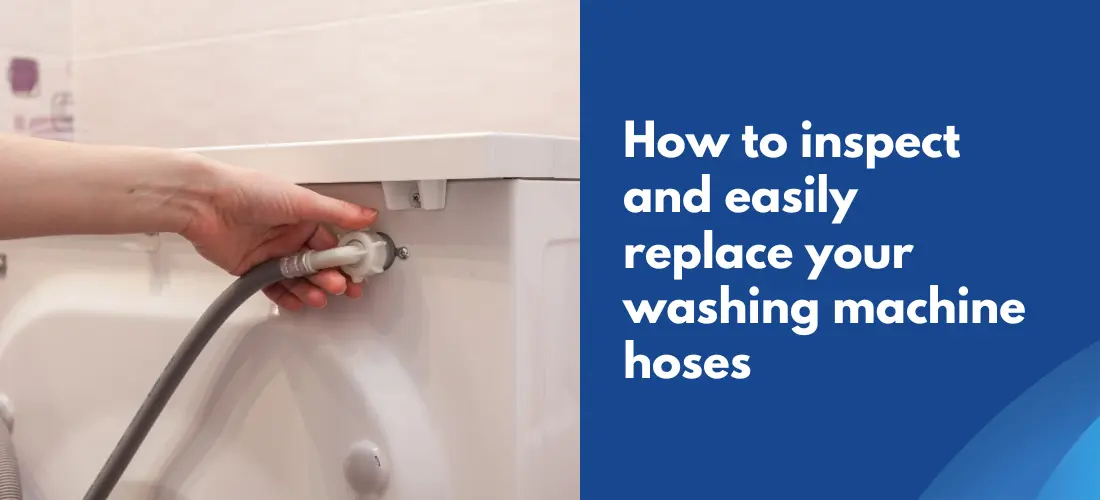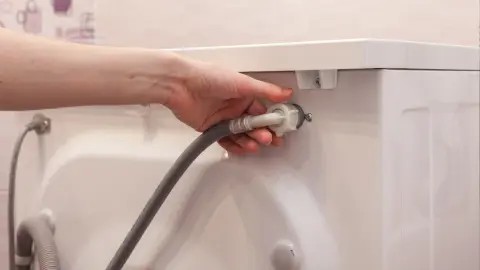We depend on our washing machine to perform at its best but like all appliances, components can be susceptible to wear and tear over time. If you notice water pooling around your washing machine or an inconsistent water flow, it could be a sign of a defective hose. Over time, washing machine hoses can degrade, leading to leaks and potential water damage. In this guide, we’ll show you how to inspect and easily replace your washing machine hoses.
Signs that your washing machine hoses may be faulty
- Visible signs of wear such as cracks, bulges or fraying
- Leaks or dampness around the hoses
- Swelling or bulging when the water is running
- Cracks or brittleness in the hose material
- Inconsistent water flow or reduced pressure during the wash cycle
- Corrosion or rust around the hose connections
- Unusual noises coming from the washing machine, like banging or rattling
Washing machine hoses typically last around 5 years, depending on usage and the type of material. If your hoses are older than this, it’s a good idea to proactively replace them, even if they appear to be in good condition.
Inspecting your washing machine hoses
Washing machine hoses are under constant pressure as they supply water to your appliance. Inspecting them regularly is crucial to identify signs of wear and prevent potential leaks or bursts that could cause extensive damage to your home.
- Visually inspect the hoses for any signs of wear, including bulges, cracks, fraying, or leaks. Pay close attention to areas near the connections, as these are common failure points.
- Run your fingers along the length of the hoses to check for soft spots or areas of weakness. Any abnormalities indicate that the hoses need replacement.
How often should you inspect your hoses?
Regular inspections help catch any potential issues early and prevent leaks or bursts that could lead to water damage. Inspect washing machine hoses at least once a year and replace them every 5 years, even if they appear to be in good condition.
- Avoid placing strain on the hoses by ensuring the washing machine is level and not overloaded.
- Periodically check the hoses for any signs of wear or leaks between inspections, especially after moving the appliance or during heavy use.
How to replace your washing machine hoses
Once you’ve identified worn-out hoses, it’s time to replace them.
What you will need:
- Pliers
- Replacement washing machine hoses – Find yours here
- Towels or rags
- Bucket or container (to catch any water that may spill)
Safety first! Turn off the water supply to the washing machine by shutting off the valves located behind the appliance and disconnect from its power source. Slide the washer away from the wall to access the hoses.
Step 1:
Using your pliers (if necessary), loosen the hose connections, starting where the hose connects to the washing machine. Have a towel or bucket handy to catch any water that may spill from the hoses.
Step 2:
Then, loosen the connection at the water supply valves (again using your pliers if necessary). Remove the old hoses and discard them.
Step 3:
Before installing the new hoses, inspect the hose connections on the washing machine and water supply valves for any debris or corrosion. Clean them if necessary.
Step 4:
Attach the new hoses to the water supply valves. Then connect to the washing machine fittings. Connect the hot water hose to the hot water connection and the cold water hose to the cold water connection. Tighten securely.
Step 5:
Turn on the water supply valves and check for any leaks around the hose connections. Tighten the connections further if needed.
Once you’ve confirmed that there are no leaks, move the washing machine back into place.
Hose maintenance tips
- Make it a habit to inspect your washing machine hoses at least once a year for signs of wear, cracks, bulges, or leaks.
- Replace washing machine hoses every 5 years to prevent potential failures due to aging.
- Consider replacing standard rubber hoses with braided stainless-steel hoses, which are more durable and less prone to bursting or leaking.
- When installing or tightening hose connections, be careful not to over-tighten them, as this can cause damage to the hoses or fittings.
- Ensure that the hoses are not kinked, bent, or twisted, as this can restrict water flow and lead to premature wear.
- Avoid placing heavy objects on top of or leaning against the hoses, as this can damage them over time.
- When your washing machine is not in use, consider turning off the water supply valves to reduce pressure on the hoses and minimise the risk of leaks.
All the latest on the Statewide blog
Visit our blog for all the latest on washing machine repairs and maintenance. We share our ultimate washing machine troubleshooting guide and give you the low down on how to easily clean your washing machine lint trip filter (plus so much more!).
Check out our YouTube channel
Need help with your home appliance repairs and maintenance? Check out our DIY videos on our YouTube Channel. All the expert hints and tips to make appliance repairs a breeze!
Find washing machine spare parts online at Statewide Appliance Spares
Search on our website by brand and model number to find replacement parts for your washing machine. We have washing machine spare parts and hoses for all the big brands including Bosch, LG, Fisher Paykel, Haier, Samsung, Simpson, Speed Queen, Miele and Westinghouse. Fast delivery and the lowest prices, guaranteed!


